An Integrated Approach to Assessing the Potential of Plastic Fishing Gear to Release Microplastics
Abstract
1. Introduction
2. Materials and Methods
- N1—thin nylon—nylon net, thin (seine net, 0.30 mm, mesh 100 mm), used in seine fisheries;
- N2—braided nylon—nylon net, thick (“braided” type, 2.3 mm, mesh 53 mm), used in seine fisheries;
- N3—braided polyethylene—polyethylene net, thin (“braided” type, 1.5 mm, mesh 50 mm), used in trawling fisheries;
- N4—twisted polyethylene—polyethylene net, thin (“twisted” type 10/24, 1.8 mm, mesh 80 mm FM), used in trawling fisheries.
2.1. Laboratory Assessment of MP Release from Fishing Nets
2.1.1. Experimental Setup
2.1.2. Microplastic Analysis
2.2. In Situ Experimental Exposure of Fishing Nets to Quasi-Real Environmental Conditions
2.2.1. Experimental Setup
2.2.2. Microplastic Analysis
2.3. Environmental Surveys of MPs in ALDFG Hotspots
2.3.1. Sampling Strategy
2.3.2. Microplastic Analysis
3. Results and Discussion
3.1. Laboratory Assessment of MP Release from Fishing Nets
3.2. In Situ Experimental Exposure of Fishing Nets to Quasi-Real Environmental Conditions
3.3. Environmental Surveys of Microplastics in ALDFG Hotspots
4. Conclusions
Supplementary Materials
Author Contributions
Funding
Data Availability Statement
Acknowledgments
Conflicts of Interest
Abbreviations
| ALDFG | abandoned, lost, or otherwise discarded fishing gear |
| EU | European Union |
| FTIR | Fourier transform infrared spectroscopy |
| MP | microplastic |
| PNLN | Parque Natural do Litoral Norte |
| PA | polyamide |
| PE | polyethylene |
| PET | polyethylene terephthalate |
| PP | polypropylene |
References
- Giskes, I.B., Jr.; Pragnell-Raasch, H.; Perez Roda, A. Report on Good Practices to Prevent and Reduce Marine Plastic Litter from Fishing Activities; FAO and IMO: Rome, Italy; London, UK, 2022. [Google Scholar]
- Richardson, K.; Asmutis-Silvia, R.; Drinkwin, J.; Gilardi, K.V.; Giskes, I.; Jones, G.; O’Brien, K.; Pragnell-Raasch, H.; Ludwig, L.; Antonelis, K.; et al. Building evidence around ghost gear: Global trends and analysis for sustainable solutions at scale. Mar. Pollut. Bull. 2019, 138, 222–229. [Google Scholar] [CrossRef] [PubMed]
- Sahrhage, D.; Lundbeck, J. A History of Fishing; Springer: Berlin/Heidelberg, Germany, 2012. [Google Scholar]
- Kim, S.H.; Kim, P.; Jeong, S.-J.; Lee, K.; Oh, W. Physical Properties of Biodegradable Fishing Net in Accordance with Heat-Treatment Conditions for Reducing Ghost Fishing. Turk. J. Fish. Aquat. Sci. 2019, 20, 127–135. [Google Scholar]
- Nelms, S.E.; Duncan, E.M.; Patel, S.; Badola, R.; Bhola, S.; Chakma, S.; Chowdhury, G.W.; Godley, B.J.; Haque, A.B.; Johnson, J.A.; et al. Riverine plastic pollution from fisheries: Insights from the Ganges River system. Sci. Total Environ. 2021, 756, 143305. [Google Scholar] [CrossRef]
- Lively, J.A.; Good, T.P. Chapter 10—Ghost Fishing. In World Seas: An Environmental Evaluation, 2nd ed.; Sheppard, C., Ed.; Academic Press: New York, NY, USA, 2019; pp. 183–196. [Google Scholar]
- Drinkwin, J. Reporting and Retrieval of Lost Fishing Gear: Recommendations for Developing Effective Programs; Food and Agriculture Organization: Rome, Italy, 2022. [Google Scholar]
- Richardson, K.; Hardesty, B.D.; Vince, J.; Wilcox, C. Global estimates of fishing gear lost to the ocean each year. Sci. Adv. 2022, 8, eabq0135. [Google Scholar] [CrossRef] [PubMed]
- European Union. New Proposal Will Tackle Marine Litter and “Ghost Fishing”. 2018. Available online: https://ec.europa.eu/newsroom/mare/items/628060/en (accessed on 22 January 2024).
- Wataniyakun, W.; Le Gall, M.; El Rakwe, M.; Karl, C.W.; Larsen, R.B. Biodegradable fishing gears: A potential solution to ghost fishing and marine plastic pollution. Mar. Pollut. Bull. 2025, 212, 117607. [Google Scholar] [CrossRef]
- Barry, J.; Rindorf, A.; Gago, J.; Silburn, B.; McGoran, A.; Russell, J. Top 10 marine litter items on the seafloor in European seas from 2012 to 2020. Sci. Total Environ. 2023, 902, 165997. [Google Scholar] [CrossRef]
- Karli Thomas, C.D.; Obaidullah, F. Ghost Gear: The Abandoned Fishing Nets Haunting Our Oceans; Greenpeace e.V.: Hamburg, Germany, 2019. [Google Scholar]
- Wasave, S.; Kamble, S.; Kazi, T.; Wasave, S.; B., S.G.; Sharma, A. A bibliometric review on ghost fishing: Impacts on marine environment and governing measures. Mar. Pollut. Bull. 2025, 212, 117604. [Google Scholar] [CrossRef]
- Gilman, E.; Antonelis, K.; Drinkwin, J.; Gorgin, S.; Suuronen, P.; Thomas, S.N.; Wilson, J. Introduction to the Marine Policy special issue on abandoned, lost and discarded fishing gear: Causes, magnitude, impacts, mitigation methods and priorities for monitoring and evidence-informed management. Mar. Policy 2023, 155, 105738. [Google Scholar] [CrossRef]
- Thushari, G.G.N.; Senevirathna, J.D.M. Plastic pollution in the marine environment. Heliyon 2020, 6, e04709. [Google Scholar] [CrossRef]
- Do, H.-L.; Armstrong, C.W. Ghost fishing gear and their effect on ecosystem services—Identification and knowledge gaps. Mar. Policy 2023, 150, 105528. [Google Scholar] [CrossRef]
- Royer, S.-J.; Corniuk, R.N.; McWhirter, A.; Lynch, H.W.; Pollock, K.; O’Brien, K.; Escalle, L.; Stevens, K.A.; Moreno, G.; Lynch, J.M. Large floating abandoned, lost or discarded fishing gear (ALDFG) is frequent marine pollution in the Hawaiian Islands and Palmyra Atoll. Mar. Pollut. Bull. 2023, 196, 115585. [Google Scholar] [CrossRef] [PubMed]
- Rafa, N.; Ahmed, B.; Zohora, F.; Bakya, J.; Ahmed, S.; Ahmed, S.F.; Mofijur, M.; Chowdhury, A.A.; Almomani, F. Microplastics as carriers of toxic pollutants: Source, transport, and toxicological effects. Environ. Pollut. 2024, 343, 123190. [Google Scholar] [CrossRef]
- Zhang, X.; Li, S.; Liu, Y.; Yu, K.; Zhang, H.; Yu, H.; Jiang, J. Neglected microplastics pollution in the nearshore surface waters derived from coastal fishery activities in Weihai, China. Sci. Total Environ. 2021, 768, 144484. [Google Scholar] [CrossRef]
- Dimassi, S.N.; Hahladakis, J.N.; Yahia, M.N.D.; Ahmad, M.I.; Sayadi, S.; Al-Ghouti, M.A. Degradation-fragmentation of marine plastic waste and their environmental implications: A critical review. Arab. J. Chem. 2022, 15, 104262. [Google Scholar] [CrossRef]
- Coyle, R.; Hardiman, G.; Driscoll, K.O. Microplastics in the marine environment: A review of their sources, distribution processes, uptake and exchange in ecosystems. Case Stud. Chem. Environ. Eng. 2020, 2, 100010. [Google Scholar] [CrossRef]
- Horton, A.A.; Walton, A.; Spurgeon, D.J.; Lahive, E.; Svendsen, C. Microplastics in freshwater and terrestrial environments: Evaluating the current understanding to identify the knowledge gaps and future research priorities. Sci. Total Environ. 2017, 586, 127–141. [Google Scholar] [CrossRef]
- Defontaine, S.; Sous, D.; Tesan, J.; Monperrus, M.; Lenoble, V.; Lanceleur, L. Microplastics in a salt-wedge estuary: Vertical structure and tidal dynamics. Mar. Pollut. Bull. 2020, 160, 111688. [Google Scholar] [CrossRef] [PubMed]
- Antunes, J.; Frias, J.; Sobral, P. Microplastics on the Portuguese coast. Mar. Pollut. Bull. 2018, 131, 294–302. [Google Scholar] [CrossRef]
- Almeida, C.M.R.; Sáez-Zamacona, I.; Silva, D.M.; Rodrigues, S.M.; Pereira, R.; Ramos, S. The Role of Estuarine Wetlands (Saltmarshes) in Sediment Microplastics Retention. Water 2023, 15, 1382. [Google Scholar] [CrossRef]
- Rodrigues, S.M.; Almeida, C.M.R.; Silva, D.; Cunha, J.; Antunes, C.; Freitas, V.; Ramos, S. Microplastic contamination in an urban estuary: Abundance and distribution of microplastics and fish larvae in the Douro estuary. Sci. Total Environ. 2019, 659, 1071–1081. [Google Scholar] [CrossRef]
- Rodrigues, S.M.; Almeida, C.M.R.; Ramos, S. Microplastics contamination along the coastal waters of NW Portugal. Case Stud. Chem. Environ. Eng. 2020, 2, 100056. [Google Scholar] [CrossRef]
- Espincho, F.; Pereira, R.; Rodrigues, S.M.; Silva, D.M.; Almeida, C.M.R.; Ramos, S. Assessing Microplastic Contamination in Zooplanktonic Organisms from Two River Estuaries. Water 2024, 16, 992. [Google Scholar] [CrossRef]
- Bom, F.C.; Sá, F. Concentration of microplastics in bivalves of the environment: A systematic review. Environ. Monit. Assess. 2021, 193, 846. [Google Scholar] [CrossRef]
- Gérigny, O.; Pedrotti, M.L.; El Rakwe, M.; Brun, M.; Pavec, M.; Henry, M.; Mazeas, F.; Maury, J.; Garreau, P.; Galgani, F. Characterization of floating microplastic contamination in the bay of Marseille (French Mediterranean Sea) and its impact on zooplankton and mussels. Mar. Pollut. Bull. 2022, 175, 113353. [Google Scholar] [CrossRef] [PubMed]
- Pereira, R.; Rodrigues, S.M.; Silva, D.; Freitas, V.; Almeida, C.M.R.; Ramos, S. Microplastic contamination in large migratory fishes collected in the open Atlantic Ocean. Mar. Pollut. Bull. 2023, 186, 114454. [Google Scholar] [CrossRef] [PubMed]
- Rodrigues, S.M.; Almeida, C.M.R.; Ramos, S. Adaptation of a laboratory protocol to quantity microplastics contamination in estuarine waters. MethodsX 2019, 6, 740–749. [Google Scholar] [CrossRef]
- Castiglioni, M.; Rodrigues, S.M.; Freitas, V.; Rivoira, L.; Bruzzoniti, M.C.; Almeida, C.M.; Ramos, S. Microplastic in marine environment: Reworking and optimization of two analytical protocols for the extraction of microplastics from sediments and oysters. MethodsX 2020, 7, 101116. [Google Scholar]
- Erni-Cassola, G.; Zadjelovic, V.; Gibson, M.I.; Christie-Oleza, J.A. Distribution of plastic polymer types in the marine environment; A meta-analysis. J. Hazard. Mater. 2019, 369, 691–698. [Google Scholar] [CrossRef]
- Carretero, O.; Gago, J.; Filgueiras, A.V.; Viñas, L. The seasonal cycle of micro and meso-plastics in surface waters in a coastal environment (Ría de Vigo, NW Spain). Sci. Total Environ. 2022, 803, 150021. [Google Scholar] [CrossRef]
- Prata, J.C.; da Costa, J.P.; Lopes, I.; Duarte, A.C.; Rocha-Santos, T. Environmental status of (micro)plastics contamination in Portugal. Ecotoxicol. Environ. Saf. 2020, 200, 110753. [Google Scholar] [CrossRef]
- Nunes, B.Z.; Huang, Y.; Ribeiro, V.V.; Wu, S.; Holbech, H.; Moreira, L.B.; Xu, E.G.; Castro, I.B. Microplastic contamination in seawater across global marine protected areas boundaries. Environ. Pollut. 2023, 316, 120692. [Google Scholar] [CrossRef] [PubMed]
- GESAMP. Sea-Based Sources of Marine Litter. 2021. Available online: http://www.gesamp.org/publications/sea-based-sources-of-marine-litter (accessed on 19 February 2025).
- Napper, I.E.; Wright, L.S.; Barrett, A.C.; Parker-Jurd, F.N.F.; Thompson, R.C. Potential microplastic release from the maritime industry: Abrasion of rope. Sci. Total Environ. 2022, 804, 150155. [Google Scholar] [CrossRef] [PubMed]
- Pereira, R.; Rodrigues, S.M.; Silva, D.M. Ramos Assessing Environmental Control on Temporal and Spatial Patterns of Larval Fish Assemblages in a Marine Protected Area. Ecologies 2023, 4, 288–309. [Google Scholar] [CrossRef]
- Preston-Whyte, F.; Silburn, B.; Meakins, B.; Bakir, A.; Pillay, K.; Worship, M.; Paruk, S.; Mdazuka, Y.; Mooi, G.; Harmer, R.; et al. Meso- and microplastics monitoring in harbour environments: A case study for the Port of Durban, South Africa. Mar. Pollut. Bull. 2021, 163, 111948. [Google Scholar] [CrossRef]
- Prata, J.C.; Godoy, V.; da Costa, J.P.; Calero, M.; Martín-Lara, M.A.; Duarte, A.C.; Rocha-Santos, T. Microplastics and fibers from three areas under different anthropogenic pressures in Douro river. Sci. Total Environ. 2021, 776, 145999. [Google Scholar] [CrossRef]
- Nakakuni, M.; Nishida, M.; Nishibata, R.; Kishimoto, K.; Yamaguchi, H.; Ichimi, K.; Ishizuka, M.; Suenaga, Y.; Tada, K. Convergence zones of coastal waters as hotspots for floating microplastic accumulation. Mar. Pollut. Bull. 2024, 206, 116691. [Google Scholar] [CrossRef]
- Taha, Z.D.; Amin, R.M.; Anuar, S.T.; Nasser, A.A.A.; Sohaimi, E.S. Microplastics in seawater and zooplankton: A case study from Terengganu estuary and offshore waters, Malaysia. Sci. Total Environ. 2021, 786, 147466. [Google Scholar] [CrossRef]
- Ourmieres, Y.; Arnaud, M.; Deixonne, P.; Ghiglione, J.-F.; Albignac, M.; Poulain-Zarcos, M.; Mercier, M.; Halle, A.T. Inferring microplastics origins in the Mediterranean Sea by coupling modelling and in-situ measurements. Mar. Pollut. Bull. 2023, 195, 115333. [Google Scholar] [CrossRef]
- European Commission and Joint Research Centre. Guidance on the Monitoring of Marine Litter in European Seas—An Update to Improve the Harmonised Monitoring of Marine Litter Under the Marine Strategy Framework Directive; Publications Office of the European Union: Brussels, Luxembourg, 2023. [Google Scholar]
- Grimstad, S.M.F.; Ottosen, L.M.; James, N.A. Marine Plastics: Innovative Solutions to Tackling Waste; Springer Nature: Cham, Switzerland, 2023. [Google Scholar]
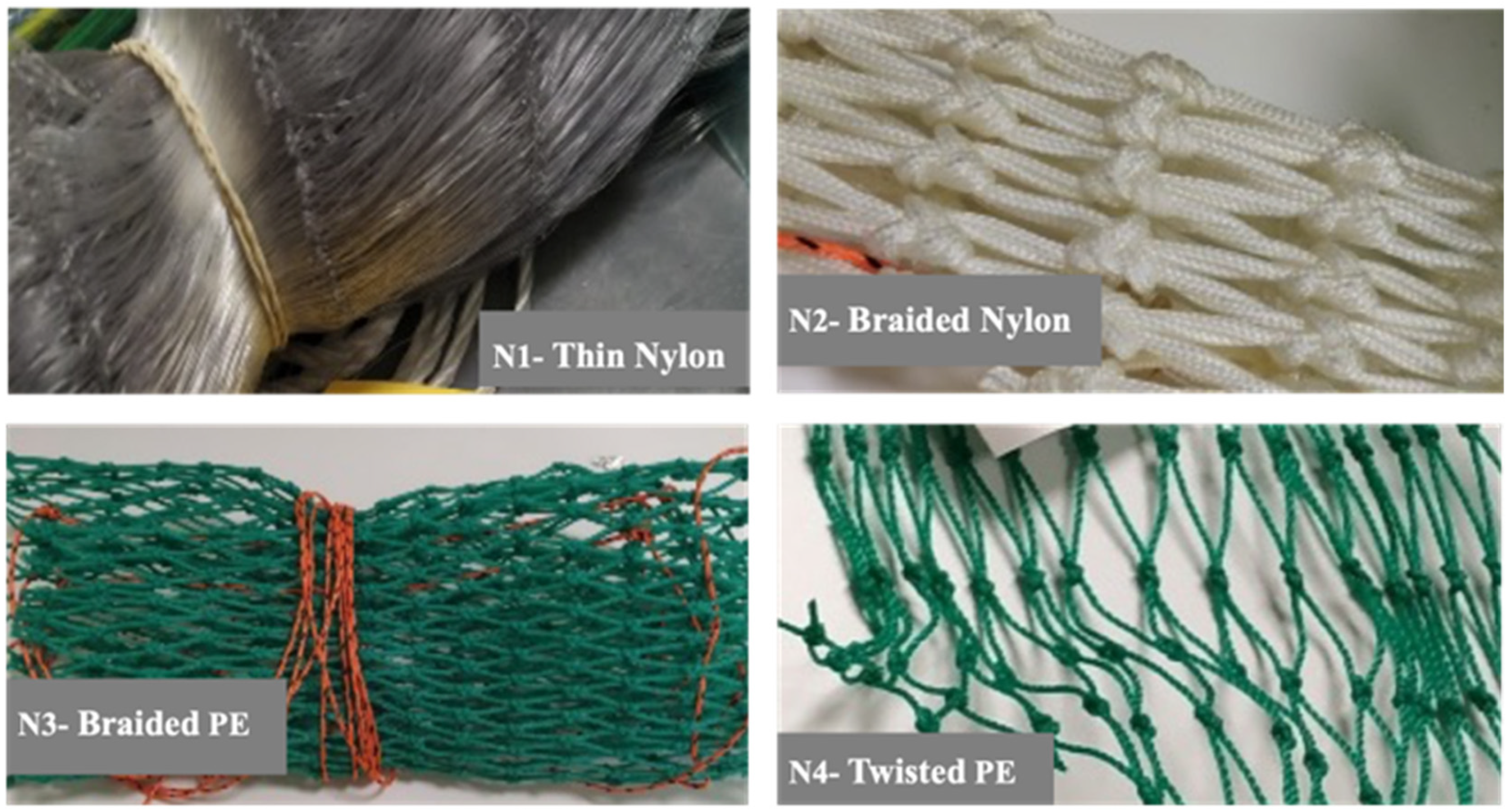

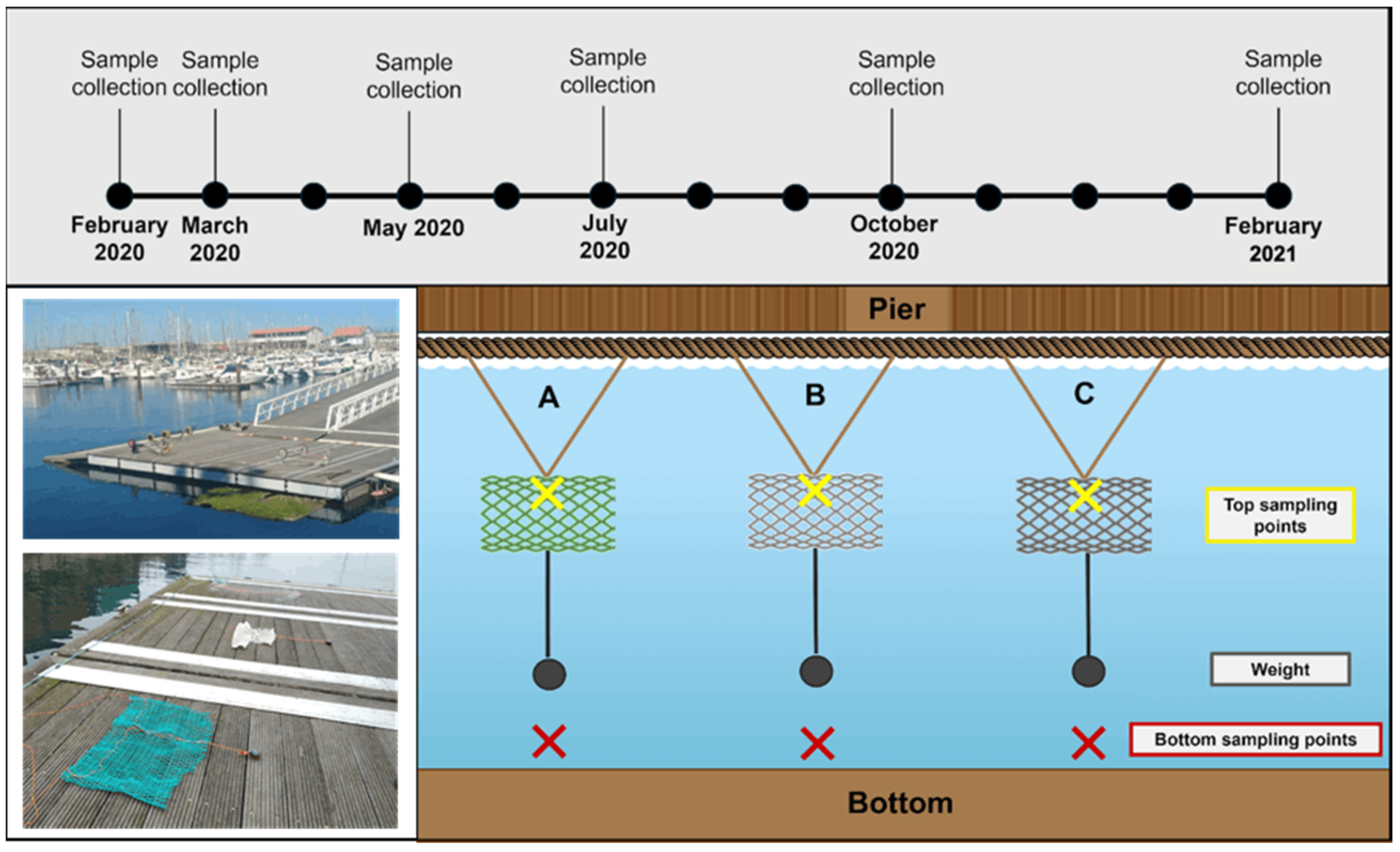
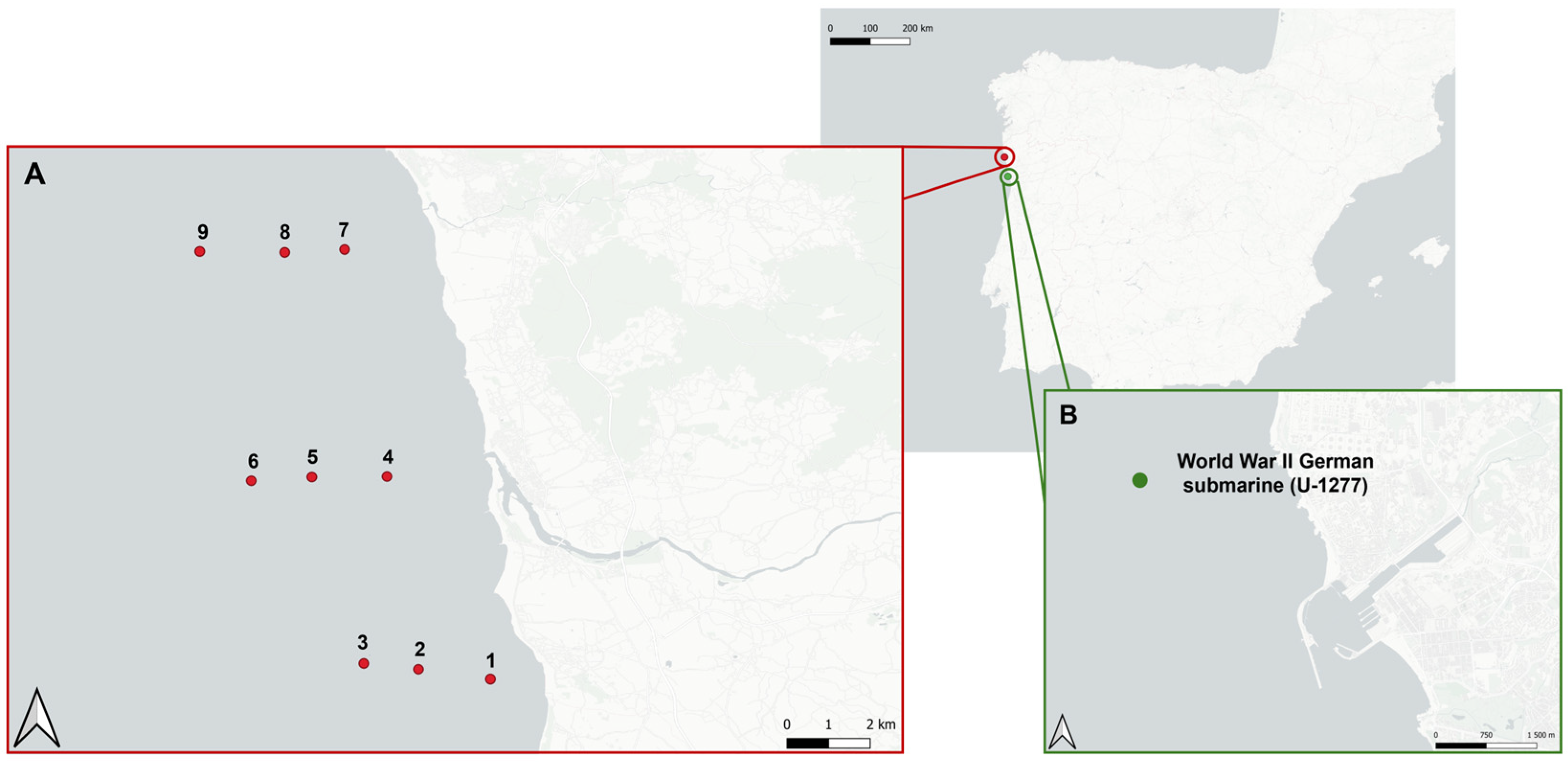
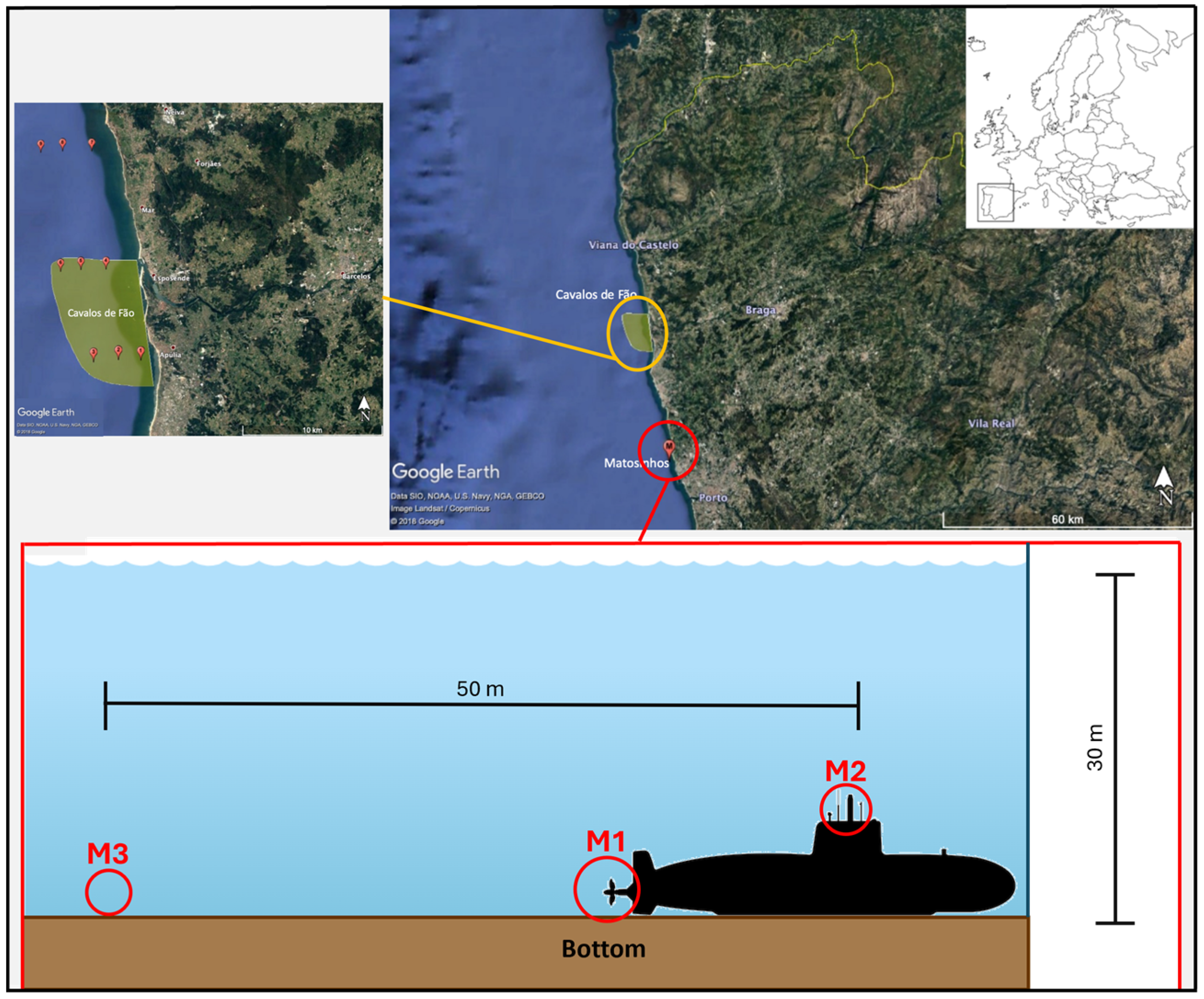

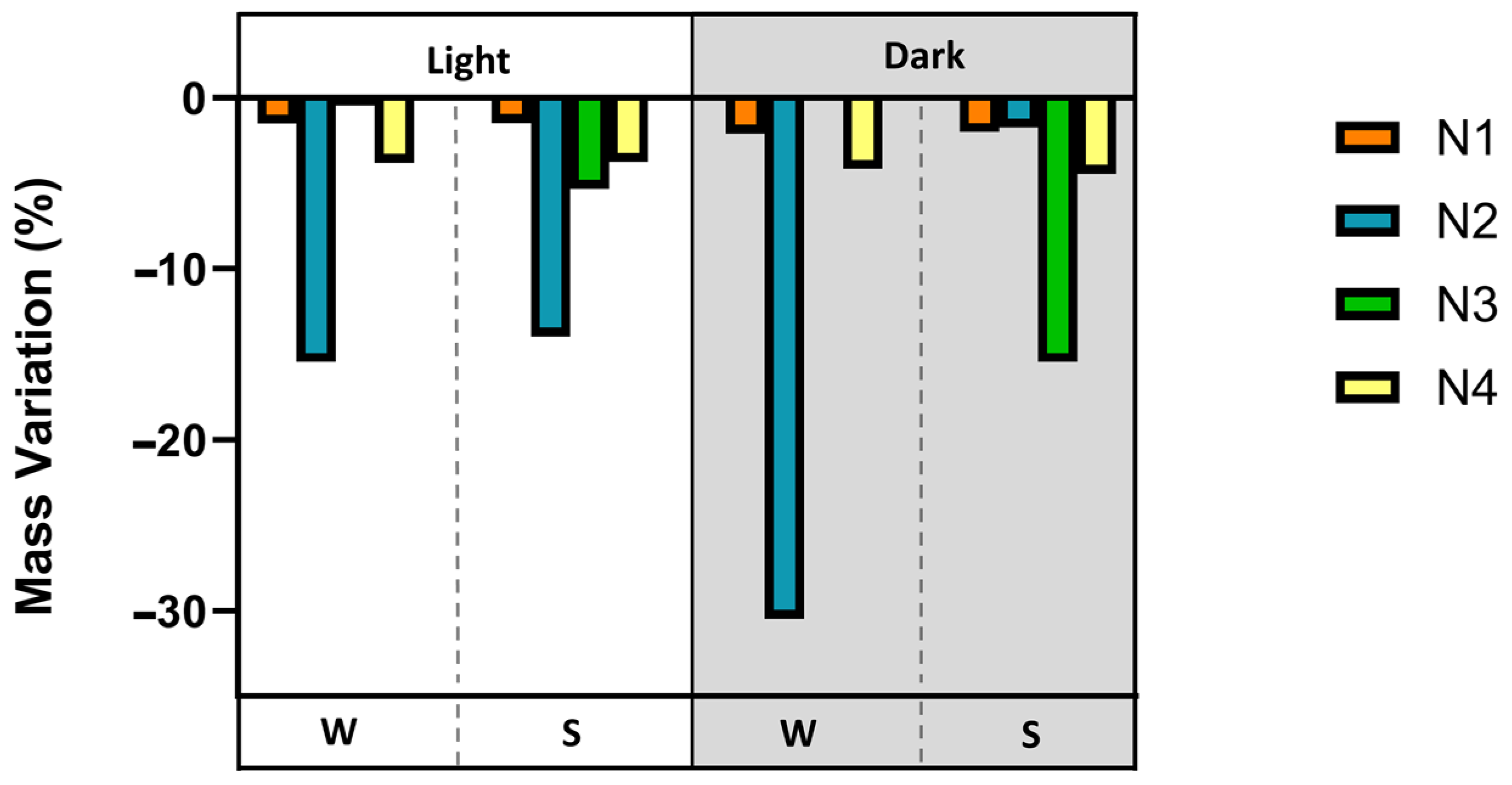
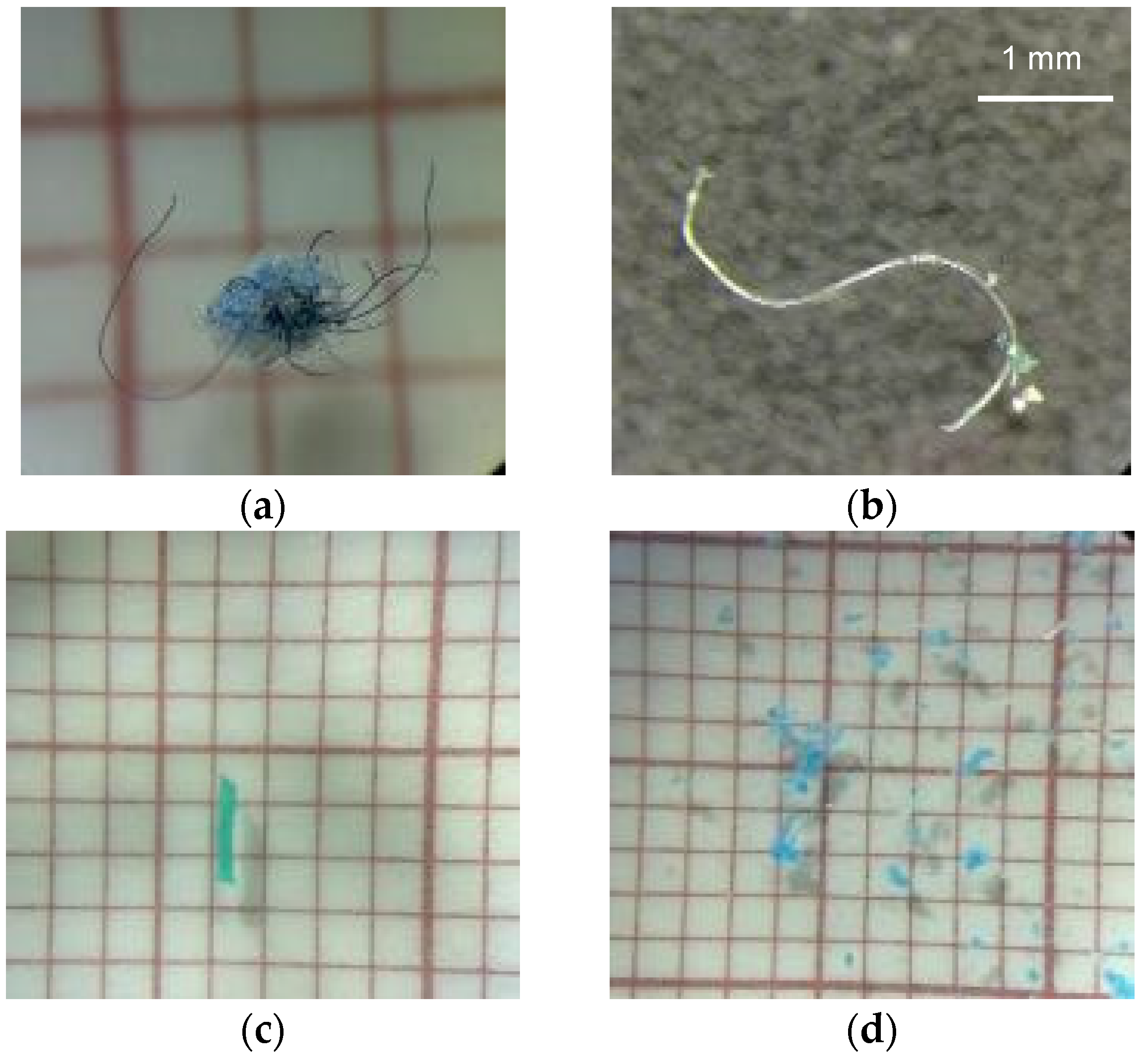
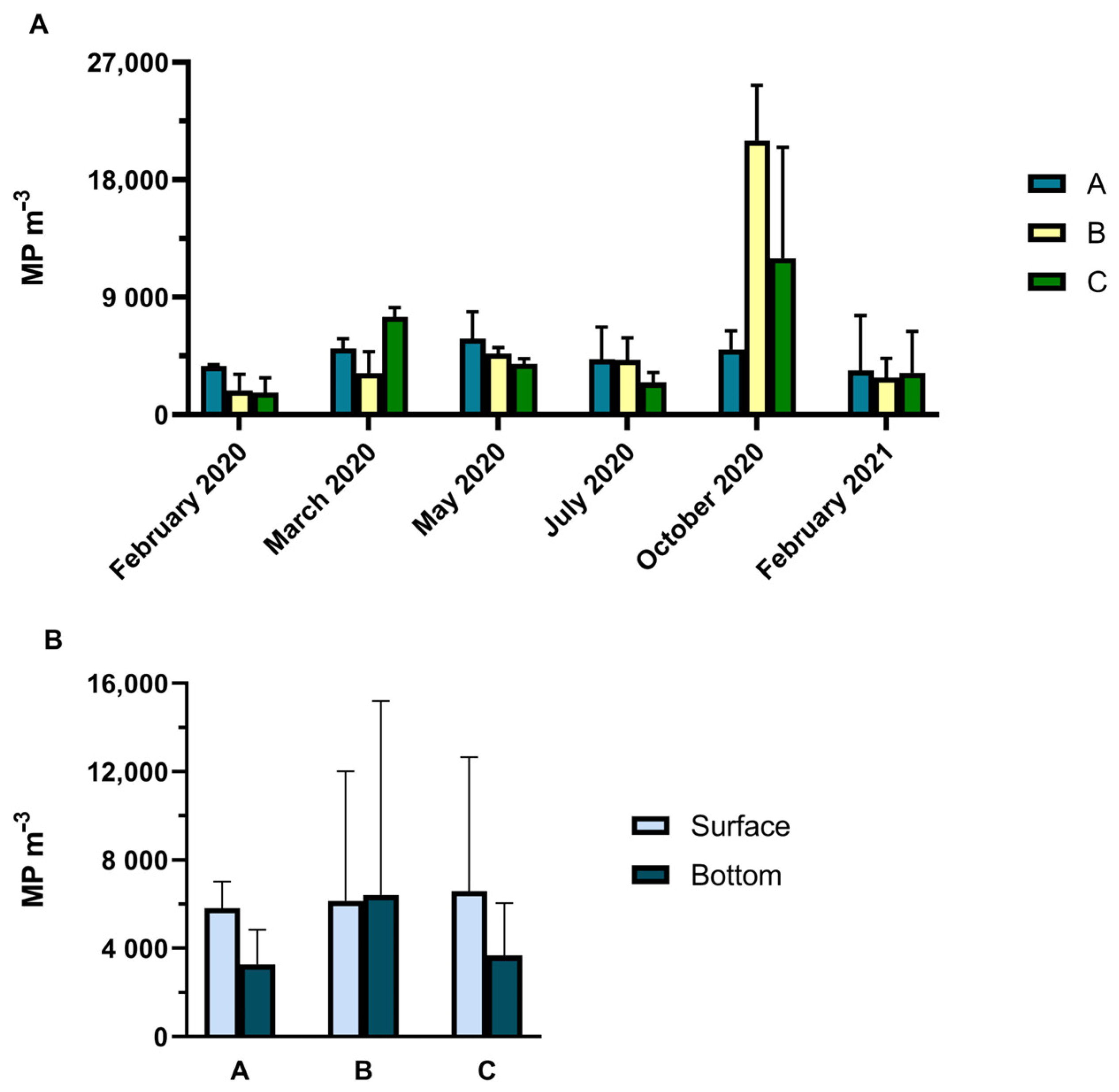

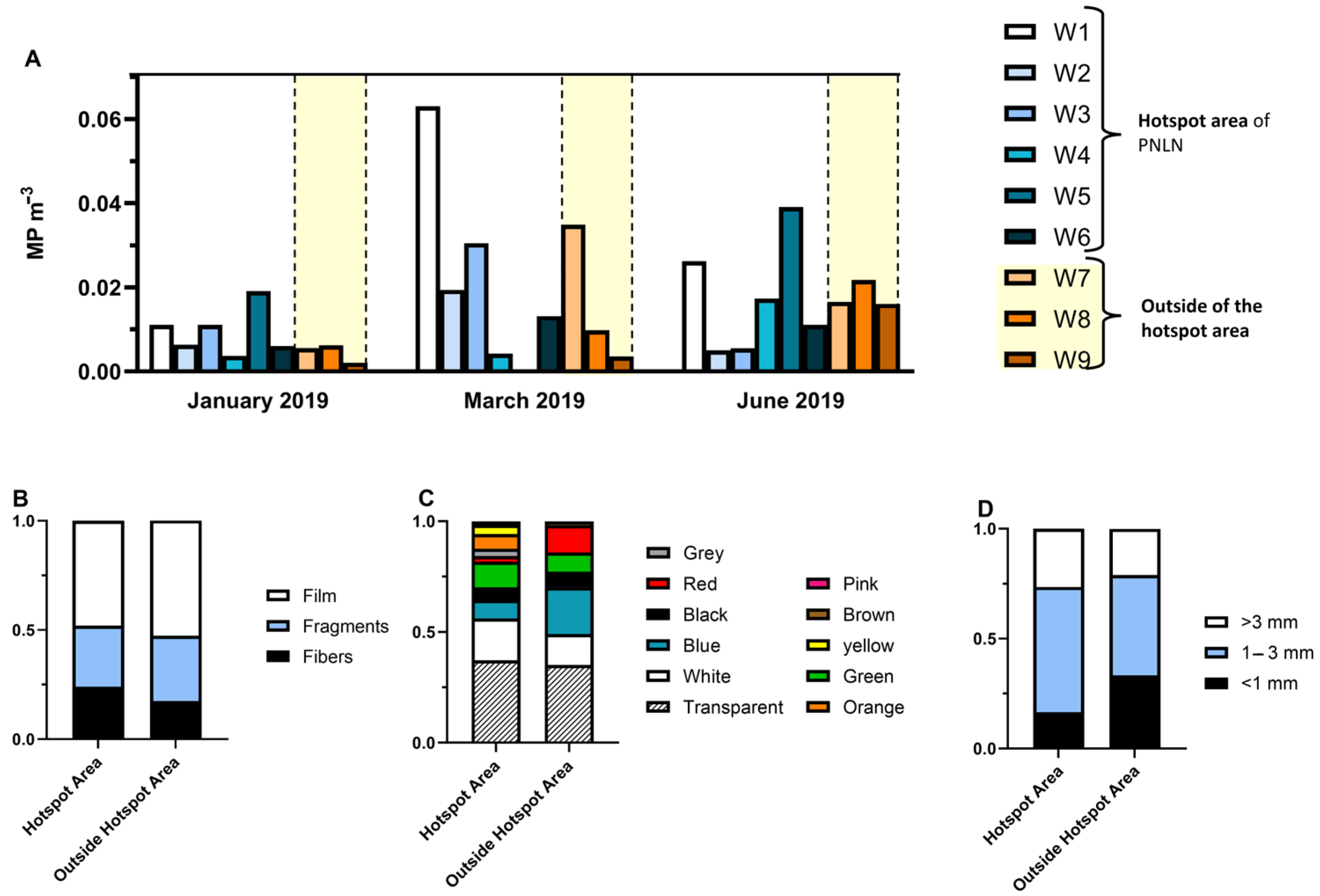


| Type of Fishing Net | Light Conditions | Sediment | |
|---|---|---|---|
| N1WL | N1—Thin Nylon | L (Light) | W (water) |
| N1SL | N1—Thin Nylon | L (Light) | S (water + sediment) |
| N2WL | N2—Braided Nylon | L (Light) | W (water) |
| N2SL | N2—Braided Nylon | L (Light) | S (water + sediment) |
| N3WL | N3—Braided PE | L (Light) | W (water) |
| N3SL | N3—Braided PE | L (Light) | S (water + sediment) |
| N4WL | N4—Twisted PE | L (Light) | W (water) |
| N4SL | N4—Twisted PE | L (Light) | S (water + sediment) |
| Control L | * | L (Light) | W (water) |
| N1WD | N1—Thin Nylon | D (Dark) | W (water) |
| N1SD | N1—Thin Nylon | D (Dark) | S (water + sediment) |
| N2WD | N2—Braided Nylon | D (Dark) | W (water) |
| N2SD | N2—Braided Nylon | D (Dark) | S (water + sediment) |
| N3WD | N3—Braided PE | D (Dark) | W (water) |
| N3SD | N3—Braided PE | D (Dark) | S (water + sediment) |
| N4WD | N4—Twisted PE | D (Dark) | W (water) |
| N4SD | N4—Twisted PE | D (Dark) | S (water + sediment) |
| Control D | * | D (Dark) | W (water) |
| Experimental Condition | Microplastic (n) | Type | Polymer |
|---|---|---|---|
| N1SD | 1 (blue) | Particle mixed with fibers | Polyethylene terephthalate (PET) |
| N2SD | 1 (white) | Fiber | Non-plastic particle |
| N3SL | 1 (green) | Fiber | Polyethylene terephthalate (PE) |
| N4WL | Several (blue) | Particles | Polypropylene (PP) |
| Sample | Type | Polymer | Search Score |
|---|---|---|---|
| BS | Swap | PE | 88% |
| BF | Particle | Polytetrafluoroethylene | 65% |
| CF | Fiber | PE | 94% |
| CF | Fiber | rayon | 59% |
| AS | Swap | PE | 85% |
| AS | Fiber | PP | 95% |
| AS | Particle | PE | 95% |
| AS | Particle | PE | 83% |
| BF | Swap | Nylon | 51% |
Disclaimer/Publisher’s Note: The statements, opinions and data contained in all publications are solely those of the individual author(s) and contributor(s) and not of MDPI and/or the editor(s). MDPI and/or the editor(s) disclaim responsibility for any injury to people or property resulting from any ideas, methods, instructions or products referred to in the content. |
© 2025 by the authors. Licensee MDPI, Basel, Switzerland. This article is an open access article distributed under the terms and conditions of the Creative Commons Attribution (CC BY) license (https://creativecommons.org/licenses/by/4.0/).
Share and Cite
Ramos, S.; Espincho, F.; Rodrigues, S.M.; Pereira, R.; Silva, D.; Rivoira, L.; Perdigão, R.; Almeida, C.M.R. An Integrated Approach to Assessing the Potential of Plastic Fishing Gear to Release Microplastics. Water 2025, 17, 1439. https://doi.org/10.3390/w17101439
Ramos S, Espincho F, Rodrigues SM, Pereira R, Silva D, Rivoira L, Perdigão R, Almeida CMR. An Integrated Approach to Assessing the Potential of Plastic Fishing Gear to Release Microplastics. Water. 2025; 17(10):1439. https://doi.org/10.3390/w17101439
Chicago/Turabian StyleRamos, Sandra, Francisca Espincho, Sabrina M. Rodrigues, Ruben Pereira, Diogo Silva, Luca Rivoira, Rafaela Perdigão, and C. Marisa R. Almeida. 2025. "An Integrated Approach to Assessing the Potential of Plastic Fishing Gear to Release Microplastics" Water 17, no. 10: 1439. https://doi.org/10.3390/w17101439
APA StyleRamos, S., Espincho, F., Rodrigues, S. M., Pereira, R., Silva, D., Rivoira, L., Perdigão, R., & Almeida, C. M. R. (2025). An Integrated Approach to Assessing the Potential of Plastic Fishing Gear to Release Microplastics. Water, 17(10), 1439. https://doi.org/10.3390/w17101439







